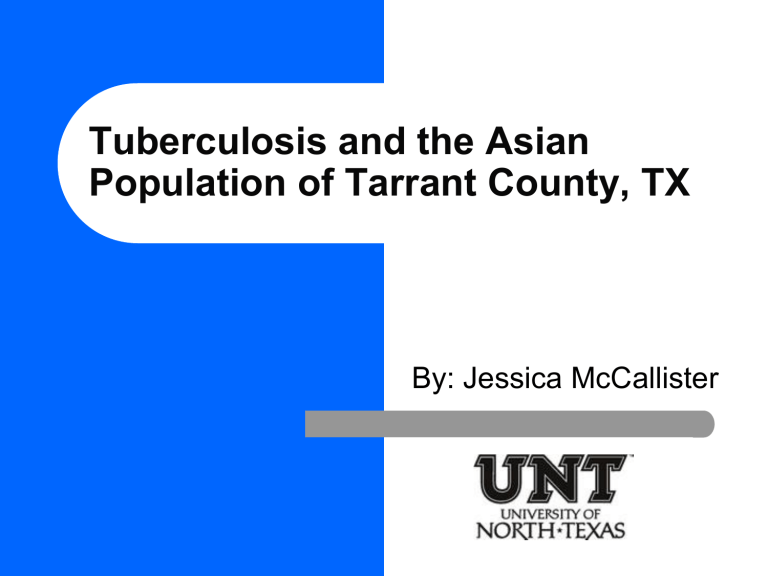The Effect of Tuberculosis on the Asian American Population

Tuberculosis and the Asian
Population of Tarrant County, TX
By: Jessica McCallister
Definition of Foreign-Born by CDC
“A U.S.-born person was defined as someone born in the United States or its associated jurisdictions or someone born in a foreign country but having at least one U.S.born parent. Persons not meeting this definition were classified as foreignborn.”
(CDC, 2008)
Problem
According to the CDC’s National TB
Surveillance System, “progress (in TB elimination) has slowed in recent years; the average annual percentage decline in the TB rate decreased from 7.3% per year during
1993-2000 to 3.8% during 20002008.”
(CDC, 2008)
Research Question
Is tuberculosis more prevalent in groups that have a high percentage of foreign-born persons?
How severe is tuberculosis prevalence among Asians in the US?
What factors drive tuberculosis transmission among Asians in Tarrant County?
Literature Review
Tuberculosis (TB) in native-born Americans has declined from
1993-2007, but foreign-born persons and racial/ethnic minority populations continue to be affected disproportionately (CDC,
2008).
In the United States alone, the percentage of Asians with tuberculosis has risen from 20 to 26 percent from 1998 to 2007
(CDC 2007).
Traditional programs targeting high-risk populations usually exclude Asians (with high rates of TB) and threaten the progress toward TB elimination in the US (CDC, 2008).
Rate of native-born cases vs. foreignborn cases (CDC, 2008)
Tuberculosis by State (CDC, 2008)
-Texas was one of four states reported by the
CDC to have more than 500 cases in
2008. (CDC, 2008)
“These four states accounted for approximately half of all TB cases in 2008.”
(CDC, 2008)
Tuberculosis Cases in Texas
Research Question
Are traditional high-risk behaviors (i.e. alcohol abuse, drug use, homelessness, sexual behavior, etc.) responsible for high rates of tuberculosis in Asians?
How does the Asian population’s participation in risky behaviors compare to other race/ethnic groups?
Methodology
Data from tuberculosisscreening program in Tarrant
County, Texas, 1993-2006.
Using contingency tables analysis with chi-square test of significance studying:
–
–
Homelessness
Incarceration
–
–
–
Drug use
Sexual behavior
Alcoholism, etc.
Asian
Total
Drug User- Crosstab
No
Non-Asian 464
146
610
Yes
210
2
212
Total
674
148
822
Results
Asians comprise 4.2% of the population but contributed 18% of TB cases.
Whites are 56% of the population and reported 26% of total cases.
Results continued..
Asians are less likely to participate in highrisk behaviors compared to other ethnic/minority groups:
–
–
–
– drug use (Χ 2 =57.426, p=.000) alcoholism (Χ 2 =39.776, p=.000) homelessness (Χ 2 =37.029, p=.000) previous incarceration (Χ 2 =27.359, p=.000)
Research Question
Since Asian Americans have been proven not to participate in the normal high-risk behaviors usually associated with TB, what is their mode of transmission?
What needs to be done in order to help decrease the rates of TB in the Asian
American culture?
Conclusion
Most Asians acquire TB in their home countries before entering US. About 96% of Asian TB cases in Tarrant
County were foreign-born.
Majority do not participate in the traditional high-risk behaviors usually associated with TB.
Specific target-programs are needed to control TB in the
Asian community in order to facilitate TB elimination in the United States.
Programs in Tarrant County,
Texas
Tarrant County offers TB skin tests, chest xrays, medications, refills, and doctor visits for low costs to county residents (TCPH, 2009).
There was no mention of screening programs that targeted specific members of the community.
What needs to be done?
Specific target-programs are needed to control TB in the Asian community in order to facilitate TB elimination in the United States.
References
CDC Statistics. 2007. Tuberculosis cases, percentages, and case rates per
100,000 population by race only: United States, 1993-2007. http://www.cdc.gov/tb/surv/2007/pdf/table3.pdf. Accessed 10 October
2008.
CDC Statistics. 2008. MMWR: Trends in Tuberculosis
—United States,
2007. http://www.cdc.gov/mmwr/preview/mmwrhtml/mm5711a2.htm
Moonan, Patrick K, Manuel Bayona, Teresa N Quitugua, Joseph Oppong,
Denise Dunbar, Kenneth C Jost Jr, Gerry Burgess, Karan P Singh, and
Stephen E Weis. 2004. Using GIS technology to identify areas of tuberculosis transmission and incidence. International Journal of Health
Geographics 3:23.
Tarrant County Public Health. Client Services: Tuberculosis, 2009. http://www.tarrantcounty.com/ehealth/cwp/view.asp?A=763&Q=4
30433
Texas Department of State Health. Tuberculosis Statistics: 2006 TB Cases in
Texas map. www.dshs.state.tx.us/idcu/disease/tb/statistics /
Acknowledgements
I would like to thank the following:
-
-
-
Dr. Joseph Oppong
Dr. Susan Eve
Dr. Gloria Cox and the
Honors College











